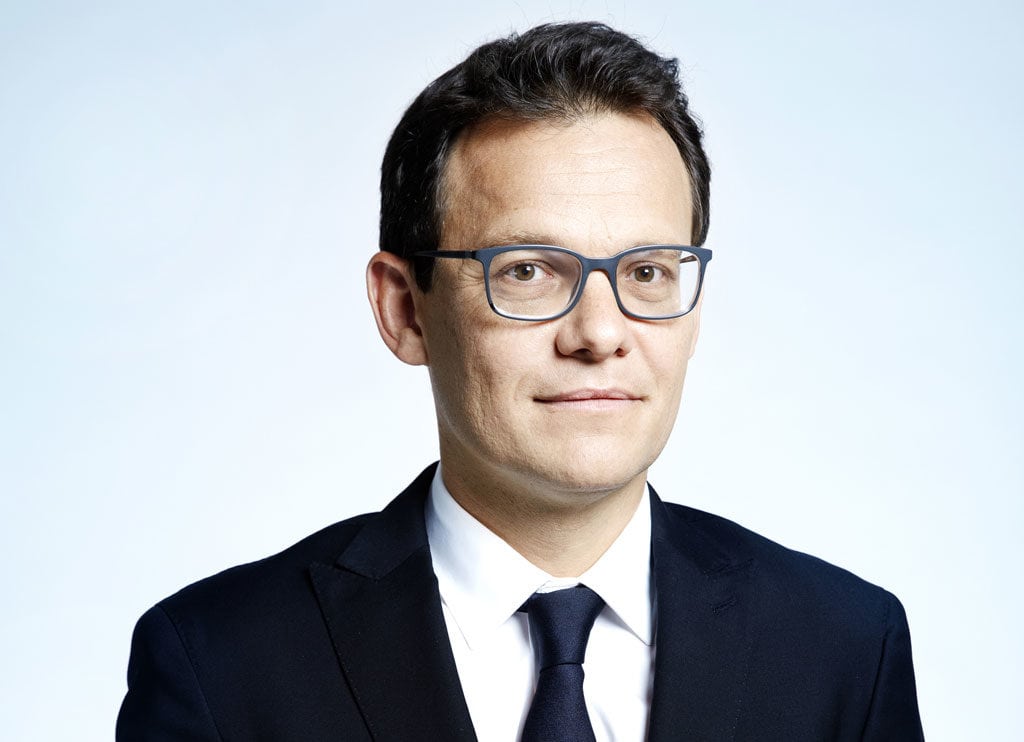Arianespace CEO on 100th Ariane 5 Mission and the Future of Launch

Arianespace Chairman and CEO Stephane Israel. Photo: Arianespace
We talk to Arianespace CEO Stéphane Israël about what the milestone 100th Ariane 5 mission means for Arianespace and the legacy of this iconic rocket, his view of the future of satellite launch, and get a sneak peek at some new developments regarding the upcoming Ariane 6 rocket.
Israël was named CEO of Arianespace in 2013. In 2016, Via Satellite presented him with its Satellite Executive of the Year Award, recognizing his company’s tremendous and consistent success launching the world’s most advanced and innovative satellites. The following interview with Israël was conducted just before the company’s historic 100th Ariane 5 launch on Tuesday.
VIA SATELLITE: Launching 100 Ariane 5 rockets is a huge achievement. How do you rank this accomplishment in Arianespace’s history?
Stéphane Israël: The Ariane 5 can now rightly take its place on the Mount Olympus of rockets! We are extremely proud of what this mission accomplishes for Intelsat, SKY Perfect JSAT, and Azercosmos — our loyal customers. The 100th Ariane 5 is also the 300th launch across all launch vehicles — Ariane, Soyuz, Vega — delivered by Arianespace.
Following this mission, the Ariane 5 will have launched a total of 207 satellites into orbit for nearly 70 different customers. Over a period of more than 15 years, this vehicle delivered 87 consecutive launches. Of which, 86 were fully successful and one had a deviation trajectory — which did not prevent the satellites from reaching their final orbits safely. Ariane 5 reliability has no equivalent in the market. And you have to remember, the Ariane 5 is not limited to GTO missions. It acquitted itself admirably to other orbits.

The Ariane 5 before its 100th mission. Photo: Arianespace
VIA SATELLITE: What do you see as the legacy of the Ariane 5 rocket?
Israël: Perhaps its greatest legacy will be the Ariane 6, whose design derives from the Ariane 5, but with greater flexibility and lower costs. After Ariane 4, Ariane 5 has created a unique link between Arianespace and its customers.
VIA SATELLITE: Can you provide us with any new updates on the development of the Ariane 6 rocket?
Israël: The groundwork for the introduction of the Ariane 6 is fully laid. European Space Agency (ESA) member states fully approved financing the transition from Ariane 5 to Ariane 6 during the June ESA Council. The Critical Design Review (CDR) is going according to schedule and will be formally passed by the end of the year. We also hit an impressive milestone back in July when we successfully test fired the P-120 C, the solid booster that will be used in common between the Vega C and Ariane 6. This follows a series of successful tests of the Vinci and Vulcain 2.1 engines. All these milestones pave the way for a July 2020 maiden flight of the Ariane 6 and allow us to start the production of the first launchers.
On the sales side, commercialization has already started. Two missions are signed for ESA and the European Commission to keep on deploying the Galileo Navigation constellation. We must continue gathering institutional missions for Ariane 6. Five more are expected for the years 2020-2022. I am also sure that we will unveil commercial achievements soon.
VIA SATELLITE: What is your assessment of the current state of the launch market? How optimistic are you that Arianespace will retain its pre-eminent position in the market?
Israël: Our industry is changing. We are probably going to see a lot more launch capacity appear after 2020. It will become a much more competitive environment. This is why we will introduce Vega C and Ariane 6 to the market in the coming two years. Our new heavy lift vehicle, the Ariane 6, can accommodate more diverse payloads, and meet more mission profiles with its restartable upper stage, larger fairing, and increased modularity offered by the two variants of the Ariane 6 with an option of either two (the A62) or four (the A64) solid boosters.
It is true that orders for GEO satellites have been few and far between. This is due to things like the collapse of the cost per bit, miniaturization, etc. But thanks to its versatility and its modularity, Ariane 6 will be adapted to new market trends, such as broadband and Earth Observation (EO) constellations. Tomorrow, the Vega C with its Small Satellite Missions System (SSMS) and the Ariane 6’s Multiple Launch System (MLS) will be uniquely equipped to handle the surge in small, micro and nanosatellites.
VIA SATELLITE: Finally, what are your goals and ambitions for Arianespace during the next year?
Israël: Our manifest is keeping us quite busy and our teams are working around the clock to prepare the Ariane 5, the Soyuz, and Vega for their respective campaigns. We may have as many as two launches a month some months. We are also busy acquainting the world with the Ariane 6 and the Vega C. While our reputation precedes us, not everyone is familiar with the capabilities of our new systems, given all of the new companies coming online every day.